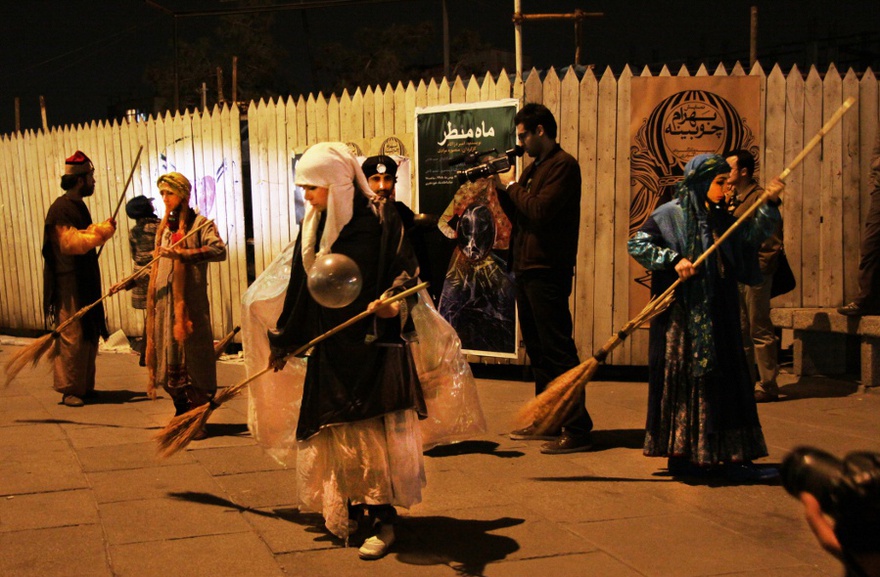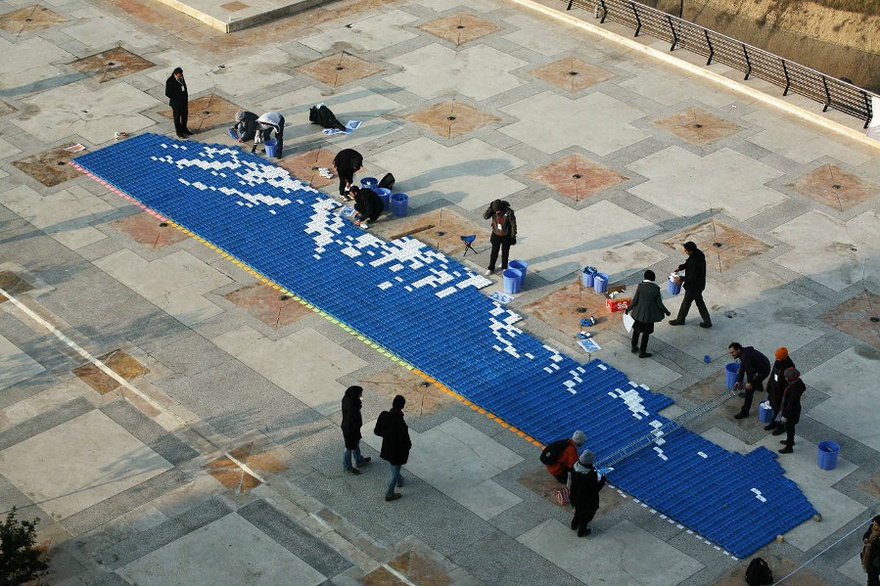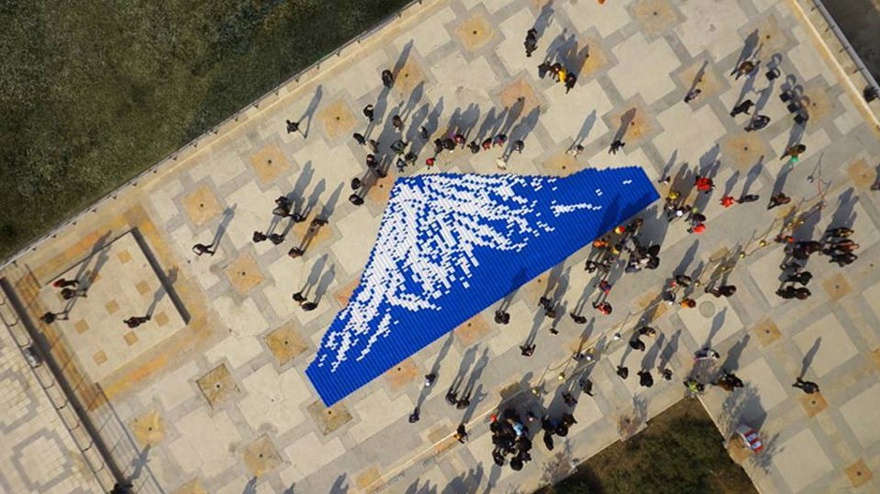Essays
Effective on the Ground and Invisible to the Global Art Market
Participatory Art in the Middle East
Participatory art in the western world has its roots in the 1960s, when the boundaries between production and consumption of art became porous. This era of post-studio art that included such practices as 'happenings', which led many critics – from Umberto Eco to Jean-Luc Nancy and Guy Debord – to theorize the social dimensions of art and the active role played by the spectator in relation to art, music, cinema, and theatre. Yet it wasn't until the 1990s that this form of art was broadly accepted as participatory art or socially engaged art, connoting not only the viewers' involvement in producing art but also their participation as a 'politicized working process', as art historian Claire Bishop puts it.[1] Such a playful approach to art and community life may be easily attributed to more progressive, democratic western societies; however, it is also plausible in the Global South.
The Middle East has a long tradition of communal and interactive art that goes beyond modern times. For centuries, participatory art was practiced by artists of all ranks. To begin with, like many other cultures, in these regions artistic expression materialized in the form of religious rituals such as ta'ziyeh, or mourning ritual. While symbolizing the spirit of resistance against tyranny, the ta'ziyeh passion play was also infused with thoughtful coordination of ordinary people who were invited to actively participate. Participation in artistic expression was not limited to religious art and rituals. Even the high-ranking professional (miniature) painters of the royal courts of Persia and the Ottoman Empire often produced their works collectively: while one mastered the portrayal of the human body, the other would be an expert in depicting foliage or animals, and so on. In fact, until the modern period and increased interactions with Europe, the idea of art being the sole product of an independent star artist was a rare phenomenon.
Although marginalized throughout the twentieth century, in recent decades, participatory art has once again gained a firm foothold among Middle Eastern artists. Such is the work of the pioneer group Oda Projesi.[2] Since 2001, the group has involved the creativity of Istanbul's ordinary citizens in alternative art spaces. While engaging and influential, the process of turning art viewing into an experience, is not yet properly defined among Middle Eastern art circles. In regional languages, this expanded field of post-studio-art is not always associated with what is commonly known as participatory, civic-engaged or collaborative art, but rather a variety of other practices, including social(ist) art, conceptual and public art. In Farsi the literal translation of participatory art is honar-e mosharekati. However, the participatory artistic productions are often called honar-e mafhoomi or conceptual art. Katılımcı sanat is the Turkish translation of 'participatory art', and yet collaborative art practices are more commonly referred to as kamusal alanda sanat which translates as 'art in public space', or 'public sphere'. In Arabic, the literal translation is fan-tasharoki, but the term fan al-ejtemiyya (which might be confused with socialist art), is the one ordinarily used. Ultimately, however, most participatory artists in the region have one thing in common – they are all in search of transforming social and political conditions on the ground. Indeed, while rooted in historic collective artistic practices, the current interest in turning art viewing into an inclusive experience is closely tied to the recent socio-political developments in the region. The 2009 Green Revolution in Iran, the 2011 'Arab Spring', and the 2013 Gezi Park Occupy movement in Turkey prompted the active participation of many creative agents. Despite oppression, civil war and internal conflicts, participatory artists have energized ordinary citizens to play a more active role in expressing their feelings, creating artistic sentiments that help heal an injured community or even trigger socio-political consciousness. Addressing examples from all countries in the region is beyond the scope of this essay. In what follows I offer a few examples from the surge of artistic interest in participation and collaboration in Tehran.
By taking their participatory art experiences into unconventional spaces, Tehran-based artists subtly question the legitimacy of official art institutions, which demand pre-exhibition scanning of all creative works. Moreover, the space in which their works are deployed is devoted entirely to interaction with audiences. In 2014, AV performers[3] opted for an old underground thermal bath in central Tehran. Based on movement, dialogue and a close relationship with the audience-reminiscent of Gardzienice or Polish experimental theatre – AV has successfully encouraged participation of its audience.
Rejected by the Annual Fajr Theater festival committee in February 2010, Noir Art Group[4] chose the open arena outside of Tehran's Rudaki Theatre (where the festival's approved performances took place) to perform, in yek seeb nist (This is not an Appel, 2010), a play that actively engaged bodily movements of female actors and audiences alike. There is more to this work than just its institutional critique. It also gives us an opportunity to rethink the limits of participatory art. By positioning their practices in unlikely places, Noir inevitably constitute a critique of participatory art of the west. Indeed, in accordance with Claire Bishop's bench mark, Noir presents an even 'better example of participatory art'.[5] That is to say, unlike many participatory artist in the western hemisphere, Noir does not tend to fill up the spaces left by the dominant power.[6] Rather it works in sites that are neither in the periphery nor in the centre and they select protagonists who are neither under absolute surveillance, nor concealed from the authorities.
Even when display in official venues is permissible, Tehran artists prefer to take their art to public places, actively engaging ordinary citizens. A case in point is Hooman Mehdizadeh-Jafari's gigantic, site-specific installation, havadar-e koochak (Little Airborne, 2014)[7]. Composed of 52,000 'found' plastic toy cars painted in blue and white and arranged in unison to depict the peak of Mount Damavand, the 2014 installation could not have become possible without engaging dozens of Tehrani citizens. Located to the north of the capital, the peak is the highest in Iran and the Middle East and is almost always covered with snow, which naturally makes it all the more discernable from every corner of the city. However, the towering mountain is often obscured due to a faintly acrid orange haze caused by automobile fuel. An appeal to the authorities to help reduce greenhouse gas emissions from vehicles, the installation also pushed the envelope by turning the experience of the audience into a subject of art. Indeed, the presence of participants makes the aerial photographs all the more complete and compelling.
Although these practices have had, for the most part, a relatively weak profile in the commercial art world, they nevertheless occupy a prominent place in everyday life of the citizens of the Middle East. Given that they have a significant impact on the ground, scholars of contemporary Middle Eastern art must begin to investigate them more systematically. Indeed, we must more actively integrate participatory practises within the global discussion platforms of Middle Eastern art.
[1] Claire Bishop, Artificial Hells: Participatory Art and the Politics of Spectatorship (London and New York: Verso, 2012), p. 2.
[2] Oda Projesi: http://odaprojesi.blogspot.com/
[3] AV Performers: https://maptia.com/jeremysuyker/stories/iran-s-underground-art-scene
[4] Noir Art Group: http://noir.ir/?page_id=1032
[5] Bishop, ibid., p. 283.
[6] Here I am referring to the French philosopher Jacques Renciere's thoughts on participation in his book, On the Shores of Politics (London: Verso, c. 2007), p. 60.
[7] havadar-e koochak: http://www.hoomanmehdizadeh.com/about/


















